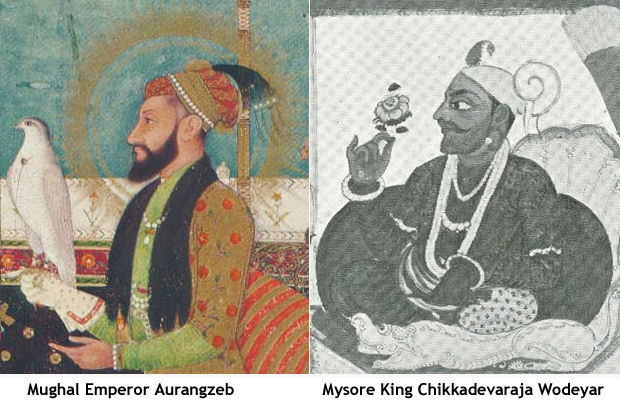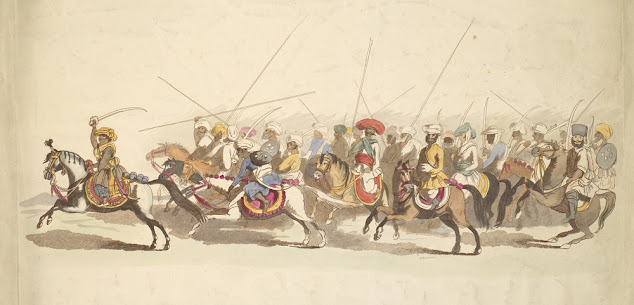Aurangzeb’s friendly relations with Chikkadevaraja Wodeyar, Mysore Kingdom’s most successful independent Hindu King
Research and author: Ameen Ahmed
~~~
The Hindu Wodeyar dynasty formed the Mysore kingdom in 1399.1 It ruled the region until India’s independence, with a couple of breaks in between, from 1760 to 1799 and 1831 to 1881. Established as a subsidiary of the Karnata Empire (popular as Vijayanagar Empire), the Wodeyars began to spread their wings after Vijayanagar was sacked at the battle of Talikoti in 1565.2 During its long existence it saw the rise and fall of many empires, including the Mughals and Marathas. Chikkadevaraja Wodeyar who ruled from 1673 until his death in 1704, is seen as its most successful king. This essay highlights how this far sighted ruler developed and sustained friendship with Aurangzeb to not only check their common enemy the Marathas, but also to reform his kingdom.
 |
| Mysore King Chikkadevaraja Wodeyar built or repaired many Hindu temples in his reign, like this Shvetha Varaha Swamy temple at Mysore. Picture by the author in 2016. |
Early Marathas and Mysore Kingdom
In early 17th century CE, supported by Maratha warriors like Shahji, father of Shivaji, the Adil Shahi rulers of Bijapur expanded south. The Muslim rulers of Deccan Sultanates of Ahmadnagar and Bijapur were said to be tolerant towards their Hindus resident and provided them opportunities in civil administration as well as the military.3 Shahji was one such Hindu who excelled as a military leader in both these sultanates. The Bijapur Sultans divided the Carnatic region into Carnatic Hyderabad and Carnatic Bijapur (Vijayapura). Each of these was sub-divided into north (Balaghat) and south (Payeenghat). Sira was part of the Carnatic Bijapur Payeenghat.4 Despite the Adil Shahis sweeping through the region, Mysore Kingdom remained a separate entity. Randaulah Khan, Bijapur's Governor at Sira, attacked Srirangapatna, the capital of Mysore in 1639, located just about 170 km away. He was supported by his second in command Shahji. But they were both beaten back by Kantirava Narasa Raja Wodeyar (ibid., 3).
While Randaulah Khan returned to the Bijapur court, Shahji was given in jagir Bangalore, Kolar, Hosakote, Dod-Ballapur and Sira. He initially lived at Bangalore. During peacetime he also resided at Kolar and Doddaballapur (ibid., 1). Mallik Rehan, an Abyssinian, commanded the Bijapur armies at Sira from 1638 to 1650. Although he distinguished himself in a few decisive battles, particularly one near Bangalore in 1647, there are no records of him being able to subjugate the Mysore Wodeyars.5 In 1649, due to Shivaji’s adventures against Bijapur, Shahji was imprisoned by the Bijapur Sultan. Meanwhile, the Mysore Wodeyars were holding on firmly to Srirangapatna. Kantirava Narasa Raja Wodeyar defeated Kempe Gowda, the ruler of Magadi, in 1654, and forced him to pay tribute (ibid., 1).
Shahji continued his adventures after being spared death due to intervention of Shah Jahan and led the Bijapur armies again, when he died in 1664 falling down from a horse at the age of 70, near Basavapatna town in preset day southern Karnataka (ibid., 1). Venkoji or Ekoji, who lived at Tanjavur (anglicized: Tanjore) took over Shahji’s jagir of Bangalore and areas south of it (ibid., 4). Soon Shivaji would venture into Karnataka. A man who wanted to shape his own destiny as well as that of his clan the Marathas, he gained notoriety as a plunderer of non-Maratha kingdoms. He is known to have looted and destroyed the towns of Hubbali (Hubli), Karwar and Ankola in 1670s in present day Karnataka.6
Rise of Chikkadevaraja Wodeyar
Meanwhile, in 1672, Chikkadevaraja Wodeyar took over the reins of Mysore Kingdom. He took many steps to streamline the administration. He pioneered a regular postal system. He expanded the kingdom northward, incorporating many small territories that were in disarray due to Shivaji's raids (ibid., 1).
The cat and mice game between the numerically superior Mughals and Shivaji's men using their guerilla warfare tactics continued. In 1675, Bijapur Sultan Adil Shah died and Venkoji became independent of Bijapur. But Shivaji, a son from his father’s first marriage, attacked the domains of his half brother Venkoji and forced him to partition half of his domains, in 1677 (ibid., 4). It is said that he attacked Srirangapatna in August 1677 and resorted to looting neighbouring areas after the Wodeyar defeated him.7 By the time of his death in 1680, Maratha soldiers had entrenched themselves in the environs of Ginjee, Vellore and Tanjavur (ibid., 1).
But the Mughals and Mysore Chikkadevaraja Wodeyar kept up his pressure against the Marathas, capturing many territories that were the jagir of Venkoji. In 1682, he is said to have defeated a combined army of Basappa Nayaka of Ikkeri, Qutub Shah of Golkonda and Sambhaji, son and successor of Shivaji (ibid., 8).
Aurangzeb’s empire touches Mysore’s boundaries
Dharwar which was captured by Shivaji in 1674 was taken by Aurangzeb's son Sultan Muazzim in 1685 CE and garrisoned. 8 Aurangzeb reached Bijapur in person in 1685. Among others, he was opposed by the sons of Randaulah Khan, the late Bijapur Governor of Carnatic Bijapur (ibid., 5). Having prevailed in the battle, Aurangzeb marched down to Sira and captured it in 1687.
The Subah (province) of Sira was formed in 1687 with the town of same name as its capital. It composed of the following seven parganas (districts) - Basvapatna, Budihal, Sira, Penugonda, Dod Ballapur, Hoskote and Kolar. The states of Harpanhalli, Kondarpi, Anegundi, Bednur, Chitaldroog and Mysore were given protection as tributaries. The commercially important Bengaluru Pete (town) was still held by Venkoji, who was in the process of selling it to Chikkadevaraja Wodeyar. But Khasim Khan, Aurangzeb's first Faujdar Divan (Military Governor) of Sira, captured and sold it to the Wodeyar for three lakh rupees (ibid., 1). According to another source Kasim Khan was the Subhedar of Sira Subah (ibid., 5). Chikkadevaraja Wodeyar established friendly relations with Aurangzeb through Khasim Khan. This gave Mysore enough political stability to expand its territory in all directions, away from the Mughal boundaries. He extended Mysore’s boundaries to the south till Palni and to Midgeshi in the north (ibid., 1). The Mughals also continued capturing independent forts. The fort of Doddaballapur was captured in 1689 by Khasim Khan, according to a Persian stone inscription dated 1691.9
 |
| India in 1700 during the reign of Aurangzeb (left) and Mysore Kingdom's domains in 1704 at the death of Chikkadevaraja Wodeyar. Source: Wiki Commons |
Aurangzeb’s governance and Chikkadevaraja Wodeyar’s administration
After his friend Khasim Khan’s death, Chikkadevaraja Wodeyar made a fresh resolve to strengthen relations with the Mughal Emperor. He sent an embassy to the emperor's court at Ahmednagar in 1699. It returned in 1700 with the Emperor's authority to sit on an ivory throne and an official stamp titled Jaga Deva Raja (anglicised: Jug Deo Raj), literally meaning 'King of the world' (ibid., 1).
A year later, Chikkadevaraja Wodeyar introduced administrative reforms in his kingdom inspired by Aurangzeb’s Governance. This included the Athra Kacheri (Eighteen Departments or Chavadis), one of which was the Benne Chavadi or the Animal Husbandry Department which focused on indigenous cattle. The Athra Kacheri particularly the Benne Chavadi outlasted Chikkadevaraja Wodeyar by over a century. The latter was inherited by Haidar Ali followed by Tipu Sultan, who refined it further and renamed it as Amrut Mahal (ibid.,1). Chikkadevaraja Wodeyar also built or resurrected many Hindu temples across Mysore Kingdom among which are the two Narasimha Swamy temples at Devarayanadurga, the Kote Venkataramana temple at Bangalore and Shvetha Varaha Swamy temple in the vicinity of Mysore Palace. Many literary works in Kannada and also Sanskrit were produced during his rule (ibid., 8). He died in 1704. Aurangzeb followed in 1707. The following subehdars governed Sira until Aurangzeb's death.
Atish Khan - 1694
Kurad Manur Khan - 1697
Dhakta Manur Khan - 1704
Pudad Ulla Khan – 1706
Dawud Khan or Dawud Khan Panni - 1707 11
During their rule over Sira, the Mughals commissioned many monuments including the big Eidgah, Jumma Masjid and Barqi Masjid, among others.12 According to locals, Aurangzeb was accompanied by his favourite daughter Gauhar Taj during his campaign here. She passed away at the age of 7 and is buried in a small mausoleum in the necropolis surrounding the mausoleum of Mallik Rehan.
Conclusion
While the Maratha invasions of Bengal province (present day Bangladesh, West Bengal state, Orissa and parts of Bihar) are fairly well-known to history lovers of Indian sub-continent, the Maratha invasions of Mysore Kingdom as well as the friendly relations between Aurangzeb and his Hindu counterpart of Mysore Kingdom, Chikkadevaraja Wodeyar that protected the Kingdom's inhabitants for over two decades are not well-known. In early 20th century, another far-sighted Wodeyar king Nalvadi Krishnaraja Wodeyar took the princely state of Mysore to great heights but he was not independent from the British. That gives credence to Chikkadevaraja Wodeyar being Mysore Kingdom’s most successful independent ruler. The fact that he was deep rooted in Hinduism, and yet established friendly relations with Aurangzeb to protect his kingdom and its Hindu inhabitants, is another proof that south Asia was not a Hindu vs Muslim binary during the rule of Mughals, in particular under Aurangzeb. This unknown facet of India's history needs to be told and retold in this day and age.
References:
1. Rice, B.L., 'Mysore A Gazetteer compiled for Government', 1897.2. Jha, Monica., ‘When the south was one’. Interview of historian Vasundhara Filliozat. Downloaded on November 30, 2020 from this link link https://fountainink.in/qna/when-the-south-was-one3. ‘Imperial Gazetteer’, vol.18, 1908.4. Wilks, Mark., ‘Historical Sketches of the South of India (1564 - 1799AD)', 1817.5. Sarkar, J.N., ‘History of Aurangzeb’, in 2 volumes, 1912.6. ‘Gazetteer of the Bombay Presidency’, vol. XV, Part 2 - Kanara, 1883.7. Rao, C.H., ‘History of Mysore’, In 3 volumes, 1944.8. Gazetteer of the Bombay Presidency, vol. 22, Dharwar, 1884.9. Rice.B.L., ‘Epigraphia carnatica, Vol. 9 - Inscriptions in the Bangalore District', 1905.10. Bilimoria, J.H., ‘Letters of Aurangzeb - Rukhait e Elamgiris’, 1908.11. ‘Mysore State Gazetteer’, Tumkur District, 1969. Quotes Mackenzie’s documents from early 19th CE.12. Sibghatullah, M., 'Sira Tareeq Ke Ainay Mein', Urdu Library Centre, Bangalore, 1986.
Acknowledgement:
I thank the scholars whose works have helped me research and write this document. I am, in particular, grateful to Prof. Rank Nazeer Ahmed, USA, Nidhin Olkara, India and Muneer Ahmed, India.
~ ~ ~
~ ~ ~
You may also like to read...
Maratha attacks on temples and towns of Karnataka in 17th & 18th centuries CE.
You may also like to read...
Maratha attacks on temples and towns of Karnataka in 17th & 18th centuries CE.








Comments
Post a Comment
Thank you for visiting this blog and sharing your thoughts.